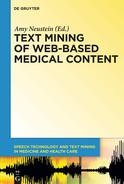Book Description
•Includes Text Mining and Natural Language Processing Methods for extracting information from electronic health records and biomedical literature.
•Analyzes text analytic tools for new media such as online forums, social media posts, tweets and video sharing.
•Demonstrates how to use speech and audio technologies for improving access to online content for the visually impaired.
Text Mining of Web-Based Medical Content examines various approaches to deriving high quality information from online biomedical literature, electronic health records, query search terms, social media posts and tweets. Using some of the latest empirical methods of knowledge extraction, the authors show how online content, generated by both professionals and laypersons, can be mined for valuable information about disease processes, adverse drug reactions not captured during clinical trials, and tropical fever outbreaks. Additionally, the authors show how to perform infromation extraction on a hospital intranet, how to build a social media search engine to glean information about patients' own experiences interacting with healthcare professionals, and how to improve access to online health information.
This volume provides a wealth of timely material for health informatic professionals and machine learning, data mining, and natural language researchers.
Topics in this book include:
•Mining Biomedical Literature and Clinical Narratives
•Medication Information Extraction
•Machine Learning Techniques for Mining Medical Search Queries
•Detecting the Level of Personal Health Information Revealed in Social Media
•Curating Layperson’s Personal Experiences with Health Care from Social Media and Twitter
•Health Dialogue Systems for Improving Access to Online Content
•Crowd-based Audio Clips to Improve Online Video Access for the Visually Impaired
•Semantic-based Visual Information Retrieval for Mining Radiographic Image Data
•Evaluating the Importance of Medical Terminology in YouTube Video Titles and Descriptions
